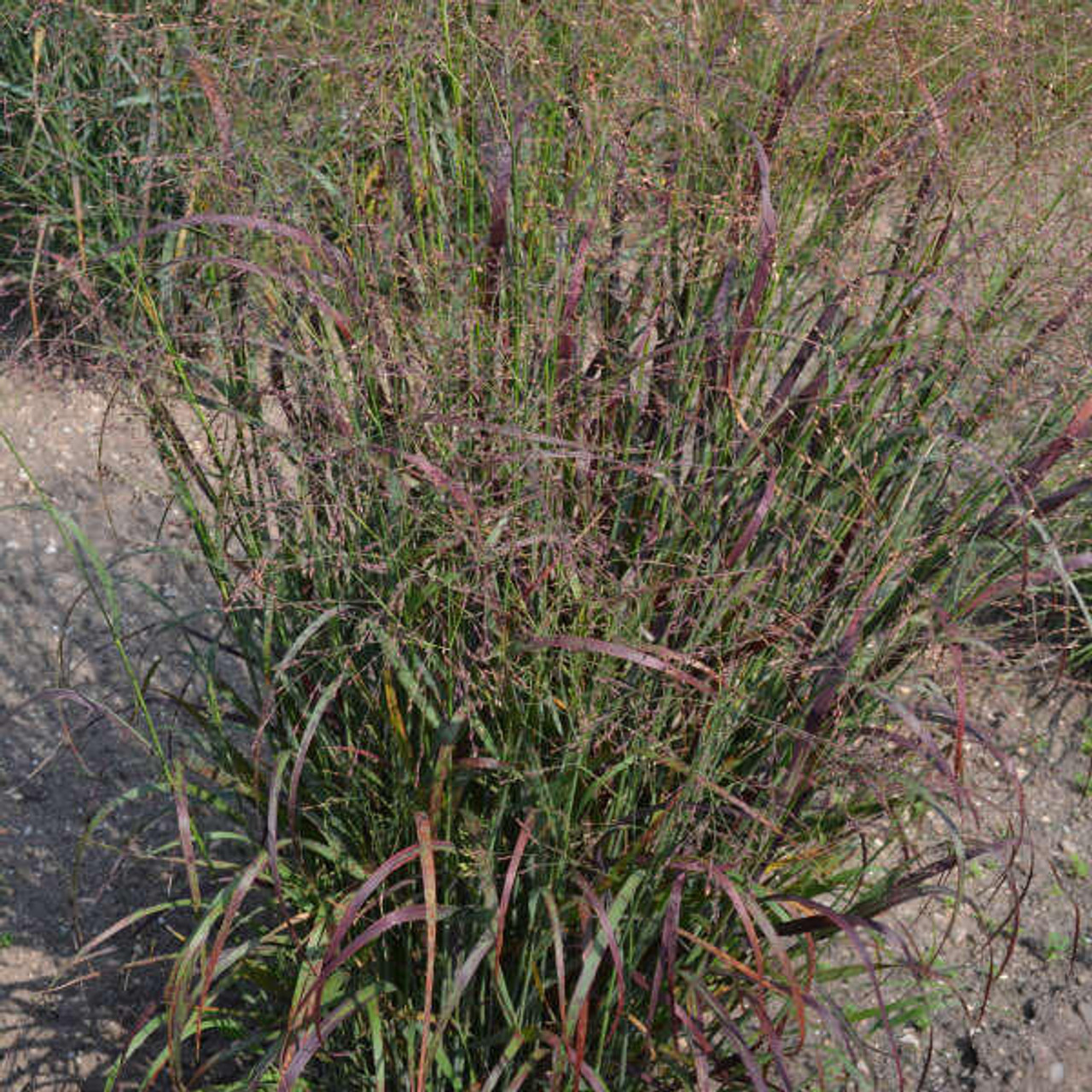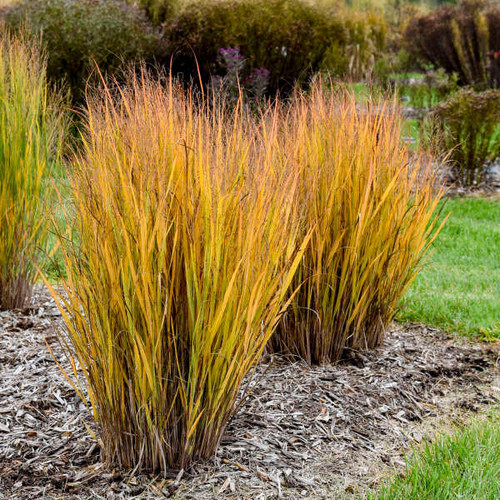Product Description
Panicum v. 'Red Flame' PPAF (30)ct Flat
Common Name: Red Switch Grass
A boldly colored grass with native roots, 'Red Flame' is primed to set your garden ablaze in late summer. This warm season grass emerges with blue-green foliage before turning almost completely wine red by summer's end. Compared with classic varieties like 'Shenandoah', 'Red Flame' has a greater saturation of red color on each leaf and incredible vigor. Use this grass for its color, texture, and durability in the landscape.
Switch grass gets its name from the peaceful swishing sound it makes when blowing in the wind. All parts of this grass are very sturdy, and will remain standing thru winter unless snows are heavy. This provides important cover for birds during the coldest days of winter. This grass is very versitile from a design standpoint; it is effective as a specimen, in masses, for screening, alongside ponds or streams, or even in large containers.
Height: 3.0-3.5 Feet
Spread: 2.0 Feet
Hardiness Zones: 4,5,6,7,8,9
Flower Color: Purple-red shades
Foliage Color: Red shades
Full Sun
Low to Consistent Water Needs
Poor to Fertile Soil Quality
Bloomtime: Late Summer
Deer Resistant
Seasonal Interest: Dried Seed Heads, Fall Color
Growth Rate: Medium
Border Plant, Cut Flower, Cut Foliage, Dried Flower, Drought Tolerant, Easy To Grow, Attractive Foliage, Mass Planting, Salt Tolerant, Focal Point, Native to North America
Panicum virgatum 'Red Flame' is a stunning variety of switchgrass that brings fiery color and graceful texture to gardens. It is a popular choice for its vibrant foliage, upright habit, and ability to thrive in a variety of conditions. Here is a closer look at what makes it special:
Appearance:
- Foliage: 'Red Flame' emerges with blue-green foliage in spring, which gradually transforms into a rich, wine-red color by late summer. The fine-textured leaves create a beautiful, flowing effect in the garden.
- Flowers: In late summer, airy clusters of tiny pink-tinged flowers appear above the foliage, adding a delicate touch to the display. These flowers eventually mature into brown seed heads that persist through winter, providing visual interest and food for birds.
Growing Conditions:
- Light: Thrives in full sun (at least 6 hours of direct sunlight) for optimal color development and a more robust growth habit. It can tolerate some light shade but may flop over in too much shade.
- Soil: Adaptable to a wide range of well-drained soils, from sandy to clay. It is tolerant of both moist and dry conditions once established.
- Water: Prefers regular watering, especially during the establishment period. Once established, it has good drought tolerance.
Characteristics:
- Mature Size: Reaches a height of 3-3.5 feet with a spread of 1-2 feet, forming an upright, clump-forming habit.
- Hardiness Zones: Suitable for USDA hardiness zones 4-9, making it a versatile choice for various climates.
- Growth Habit: Forms a dense, upright clump that adds vertical interest to the garden.
Why it is Popular:
- Vibrant Color: The fiery red foliage of 'Red Flame' creates a dramatic and eye-catching display in the garden, especially in late summer and fall.
- Native Roots: As a native grass, 'Red Flame' is well-adapted to a variety of conditions and supports local ecosystems.
- Durable: It is a tough and durable plant that can withstand heat, humidity, drought, and even periodic flooding.
- Low Maintenance: 'Red Flame' is relatively low-maintenance, requiring minimal care once established.
- Wildlife-Friendly: The flowers attract pollinators, and the seed heads provide food and shelter for birds.
Uses:
- Borders: Adds vertical interest and vibrant color to garden borders.
- Naturalized Areas: Its adaptability and native roots make it an excellent choice for naturalized areas and meadows.
- Mass Plantings: Creates a stunning display when planted in groups, providing a sea of color and texture.
- Containers: Suitable for container gardening, where its size can be controlled, and its beauty can be enjoyed on patios or balconies.
- Erosion Control: Its strong root system helps prevent erosion on slopes and banks.
Additional Information:
- 'Red Flame' is a cultivar of switchgrass (Panicum virgatum), a native North American grass.
- It is a warm-season grass, meaning it starts growing actively in late spring and reaches its peak in late summer and fall.
- Leaving the seed heads in place over winter provides visual interest and food for birds.
- Dividing clumps every few years helps maintain plant vigor and prevents overcrowding.
Overall, Panicum virgatum 'Red Flame' is a fantastic choice for gardeners seeking a vibrant, low-maintenance, and adaptable ornamental grass.
Its fiery red foliage, upright habit, and wildlife-friendly nature make it a valuable addition to any garden, bringing beauty and texture throughout the growing season and beyond.
Thirty (30) plants per flat (or tray). Approximate Plug Measurements: 4.25 inches deep x 2 inches wide.
Other Details
The most important part of the plant is its root system. Healthy roots are the foundation of a healthy, vibrant plant. The type of plug container used is based on the specific needs of the plants. Perennials offered as bare root traditionally perform better when planted as bare root.Planted in a specialized mix, potted plants have well established root systems. Top growth stage will vary depending on the current life cycle and time of year when shipped. In Winter and early Spring dormant plants may be shipped. Dormant plants may be planted right away, even before the last frost date.
Most bare root varieties are field grown for at least one season, though Hemerocallis and Hosta are grown for two seasons. The bulk of the soil is removed during the harvesting process and the tops of most varieties are trimmed back to the crown. They are graded, packed in shredded aspen or sphagnum moss and stored in freezers until ready to be shipped.
See our Container Sizes and Bare Root Perennials pages for more information.
Plant information and care is provided in the Overview section, Plant Genus Page and general information is provided in the Planting Care & Guides. Additional questions can be asked on each Plant page.
Plant Spacing: Using the maximum mature spread or width of a plant to guide spacing, ensures space to grow to full size. To fill an area sooner, plant them closer together. Just remember, future thinning or transplanting may be needed.
Water: Keep a close eye on newly planted perennials, especially throughout the first growing year. Most early plant loss is due to too much or too little water!











